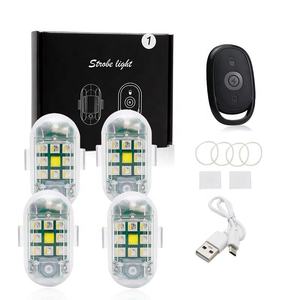(14887 products available)


































































































































































































 Ready to Ship
Ready to Ship











 Ready to Ship
Ready to Ship





A remote control flashing light is a safety light that alerts others to a hazard or dangerous situation. It is used in various industries and applications. Here are the most common types of remote control flashing lights:
Some manufacturers also offer custom flashing lights. The custom lights are designed to meet the specific needs of the customer's application. For example, a customer could request a specific flashing pattern or color, such as a remote blinking light.
Here are some specifications of the remote flashing light.
To maintain a remote control flashing light properly, always clean the lens and lamp head. This will improve the visibility of the flashing light. Check the batteries and LED light regularly to make sure they are in good working order. Take the batteries out of the light if it will not be used for a long time. This will prevent the batteries from leaking and damaging the light. Avoid shining the flashing light on people's faces to prevent eye damage. Store the flashing light in a dry, cool place, away from water, to extend the life of the light. If the flashing light is waterproof, it can last longer.
Consider the durability of the flashing emergency lights for vehicles. The flashing lights are designed to be used in emergency situations. The last thing one wants during an emergency is the lights failing. The remote flashing light may be used for warning, rescue, or guiding. It is also important for withstanding harsh conditions. It is important to ensure the flashing emergency lights for vehicles are waterproof and shock-resistant. One should also check the materials used to make the lights. The lens should be strong and tough to prevent breakage. A durable flashing light will provide reliable performance during emergencies.
When choosing a remote-controlled flashing light, consider the brightness for maximum visibility. One should choose lights that are bright enough to be seen in different weather conditions. Bright lights are easy to see from afar. This will alert other road users to the emergency. The brightness of the flashing lights is measured in lumens. The higher the lumens, the brighter the light. One should also check if the lights have multiple lighting modes. Different modes can include flashing, strobe, or steady light. The different modes will offer customizable options for various emergency situations.
When choosing remote-controlled flashing lights, one should check the battery life. The lights are often used during emergencies. They may be used for long periods before the situation is resolved. It is important to select flashing lights that have a long battery life. This will ensure the lights last for the entire duration of the emergency. One should also consider lights that have rechargeable batteries. Rechargeable batteries are cost-effective and convenient. They can be recharged using a USB cable or a charger. This allows the remote control blinking light to be used multiple times, saving money in the long run.
When selecting remote-controlled flashing lights, consider the user-friendliness. The lights should be easy to operate. One should choose lights with a simple on and off button. The lights should also have an ergonomic design. This will allow them to be held comfortably for long periods.
When choosing remote-controlled flashing lights, one should check the mounting options. The lights are designed to be mounted on vehicles. They should have various mounting options for easy installation. The lights should come with magnetic mounts, suction cups, or brackets. These will securely attach the lights to the roof or other parts of the vehicle. The mounting options should also be adjustable to direct the light in different directions.
When choosing remote-controlled flashing lights, consider the visibility. The lights are used in emergency situations to alert other road users. They should be bright enough to be seen from far away. Bright lights ensure that other motorists can see the vehicle from a distance. This will prevent accidents and guide traffic. One should choose flashing lights with high lumens for maximum visibility. The lights should also have a clear lens. Clear lenses allow the remote control flashing light to be dispersed widely to ensure it is visible in all directions.
When selecting remote-controlled flashing lights, one should check the regulations in the area of use. Different regions may have specific requirements for the type of flashing lights. Some may have rules on the color or placement of the lights. This is to ensure they do not distract other road users. One should ensure the flashing lights meet the local standards in terms of color, brightness, and mounting. This will prevent any legal issues when using the lights during an emergency.
When choosing a remote-controlled flashing light, consider the price. The lights come in different models and brands, each with varying features. One should have a budget before making a purchase. The budget should guide buyers on the type of flashing lights to buy. They should also consider the additional features that will provide value for their money.
Replacing a remote control flashing light can be done by following these simple steps below.
Before replacing a remote control blinking light, ensure all safety precautions are in place. These include wearing protective gear, shutting off the power supply to avoid electric shock, disconnecting the battery of the vehicle, and setting up the workspace with enough lighting and ventilation.
Ensure you have the right tools required for the replacement process. These include screwdrivers, wire cutters, electrical tape, wire connectors, and a replacement flashing light kit.
This is done by taking out the screws that hold the old flashing light in place and disconnecting its wires. Afterward, carefully remove the light from the vehicle.
This is done by stripping the insulation at the ends of the vehicle's power supply wires and the new flashing light's wires. Connect the wires using wire connectors and secure the connection using electrical tape.
Secure the new flashing light in place using screws. Then, connect the wires from the new light to the vehicle's power supply following the instructions provided by the manufacturer of the new flashing light. The positive and negative ends of the wires should match the vehicle's power supply.
Reconnect the vehicle's battery and turn on the power supply. Test the new flashing light to ensure it is working correctly.
If the light is not functioning properly, double-check the wiring connections and polarity. Reconnect the wires if necessary.
Q1: How do users change the batteries in a remote control flashing light?
A1: The process of changing batteries will vary depending on the type of flashing light. Generally, the cover on the back of the flashing light is removed to access the batteries. If the instructions are not available, the user can search for the product online.
Q2: Why is the flashing light not working properly after being dropped?
A2: If the flashing light is not working properly after being dropped, the internal components may have become loose or damaged. It is recommended to discontinue use and inspect the flashing light for any visible damage. If damage is found, replace the flashing light.
Q3: How can the flashing pattern of a strobe light be changed?
A3: The flashing pattern of a strobe light can be changed by pressing the relevant buttons or switches. Different models may have different ways to change strobe patterns, and it is essential to refer to the operating instructions.
Q4: What should be done if the remote control of a flashing light is not working properly?
A4: If the remote control of a flashing light is not working correctly, it is essential to check the batteries first and replace them if necessary. Also, make sure there are no obstacles blocking the signal between the remote control and the flashing light.